

Treatise on User Experience Design: Part 1. User experience design is the liaison between the three areas of technology, business, and design.
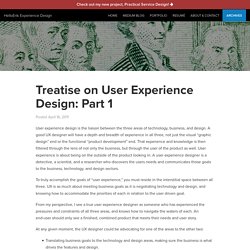
A good UX designer will have a depth and breadth of experience in all three, not just the visual “graphic design” end or the functional “product development” end. That experience and knowledge is then filtered through the lens of not only the business, but through the user of the product as well. User experience is about being on the outside of the product looking in. Zen diagram. Design de intereção - comunidade. Defining and Informing the Complex Field of User Experience (UX) Embracing the UX Spectrum. As an industry, we have the tendency to think and talk about user experience design in either a Web or a software context, where the demand to humanize complex interactive systems has been the highest.
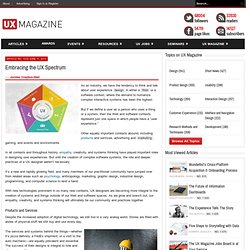
Inclusive Design. Advertisement We’ve come a long way since the days of the first Macintosh and the introduction of graphical user interfaces, going from monochrome colors to millions, from estranged mice to intuitive touchscreens, from scroll bars to pinch, zoom, flick and pan.
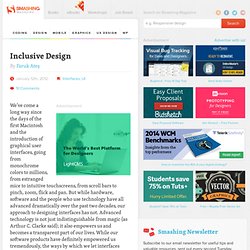
But while hardware, software and the people who use technology have all advanced dramatically over the past two decades, our approach to designing interfaces has not. Advanced technology is not just indistinguishable from magic (as Arthur C. Clarke said); it also empowers us and becomes a transparent part of our lives. While our software products have definitely empowered us tremendously, the ways by which we let interfaces integrate with our lives has remained stagnant for all these years. In the accessibility industry, the word “inclusive” is relatively commonplace; but inclusive design principles should not be reserved for the realm of accessibility alone, because they apply to many more people than “just” the lesser-abled.
Adaptive Vs. Responsive Layouts And Optimal Form Field Labels. Advertisement Editor’s note: Welcome to a new column in the UX Design section on Smashing Magazine!
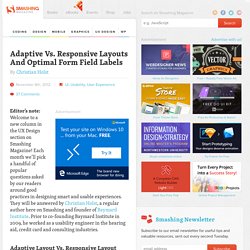
Each month we’ll pick a handful of popular questions asked by our readers around good practices in designing smart and usable experiences. They will be answered by Christian Holst1, a regular author here on Smashing and founder of Baymard Institute2. Prior to co-founding Baymard Institute in 2009, he worked as a usability engineer in the hearing aid, credit card and consulting industries.
Adaptive Layout Vs. “In which kinds of sites/projects is it better to use an adaptive layout (fixed break points)? A responsive layout[1]3 is in theory always better than an adaptive layout, but in some cases an adaptive layout is a more pragmatic solution. An adaptive layout will give you more control over the design because you only have a handful of states to consider.
An adaptive layout has its merits because it can be a more pragmatic solution that is cheaper to implement and easier to test. (cp) (jc) Adding A Personal Touch To Your Web Design. Advertisement The Web is technical by nature.
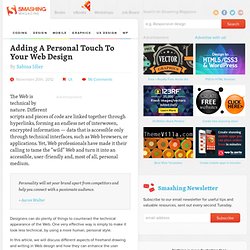
Different scripts and pieces of code are linked together through hyperlinks, forming an endless net of interwoven, encrypted information — data that is accessible only through technical interfaces, such as Web browsers, or applications. Yet, Web professionals have made it their calling to tame the “wild” Web and turn it into an accessible, user-friendly and, most of all, personal medium. Personality will set your brand apart from competitors and help you connect with a passionate audience.– Aaron Walter Designers can do plenty of things to counteract the technical appearance of the Web. Creating An Adaptive System To Enhance UX. Advertisement In computer science, the term “adaptive system” refers to a process in which an interactive system adapts its behavior to individual users based on information acquired about its user(s), the context of use and its environment.
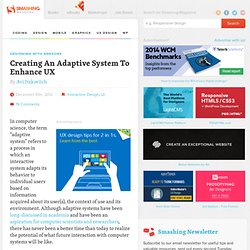
Although adaptive systems have been long-discussed in academia1 and have been an aspiration for computer scientists and researchers2, there has never been a better time than today to realize the potential of what future interaction with computer systems will be like. The abilities of today’s network information technologies to create rich, immersive personalized experiences to track interactions and aggregate and analyze them in real time, together with the data collected by the sensors we carry in our smart devices, provides us an opportunity like never before to design adaptivity in order to ultimately offer a better user experience that is both unobtrusive and transparent. iOS Human Interface Guidelines: Introduction. iOS Mobile Patterns Library. Tendência de UI: Flat Design - Choco La Design.
A showcase of flat UI design. Flat Icons. As disciplinas e as indisciplinas de UX. Eu trabalho com Experiência do Usuário há quase 10 anos, desde quando pedi demissão do meu emprego de webdesigner para virar um consultor especializado.
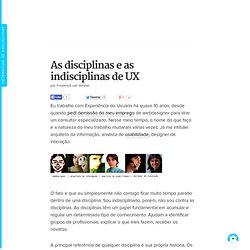
Nesse meio tempo, o nome do que faço e a natureza do meu trabalho mudaram várias vezes. Já me intitulei arquiteto da informação, analista de usabilidade, designer de interação. O fato é que eu simplesmente não consigo ficar muito tempo parado dentro de uma disciplina. Sou indisciplinado, porém, não sou contra as disciplinas. As disciplinas têm um papel fundamental em acumular e regular um determinado tipo de conhecimento. A principal referência de qualquer disciplina é sua própria história. Lembro-me de uma palestra do Luli Radfahrer que assisti no começo da minha carreira, em 2003, sobre a importância de não ficar preso à disciplinas específicas. Eu já fui webmaster, porém, não fiquei na disciplina até que ela perdesse totalmente sua credibilidade.
Disciplinas são criadas e outras esvaziadas em questão de anos. Smashing UX Design — Usability, Psychology and Information Architecture. Category: UX Design.
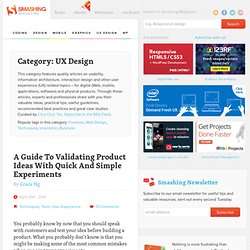
UI/UX projects on Behance.